Creating an Air Waybill
Air waybills (AWBs) can be created from within an air export shipment record or from within an air export consolidation record.
Create an Air Waybill from within a Shipment Record
Click on the Export module on the bottom left hand side of the screen, then click on the Shipments folder on top left hand side of the screen. A list of shipment records will appear. Double click on a shipment record to open it.
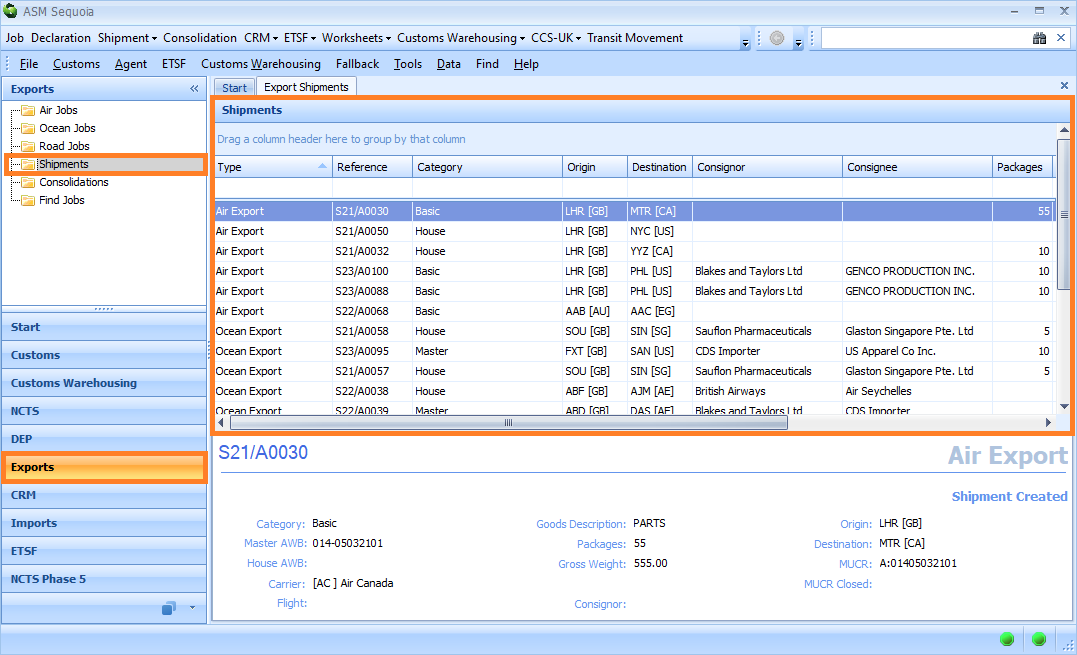
An Air Shipment editor will appear. Click on Documentation on the toolbar at the top of the editor, followed by Air Waybill on the resulting drop down menu. The type of air waybill that will be created depends on what is entered into the Category box of the Air Shipment editor.
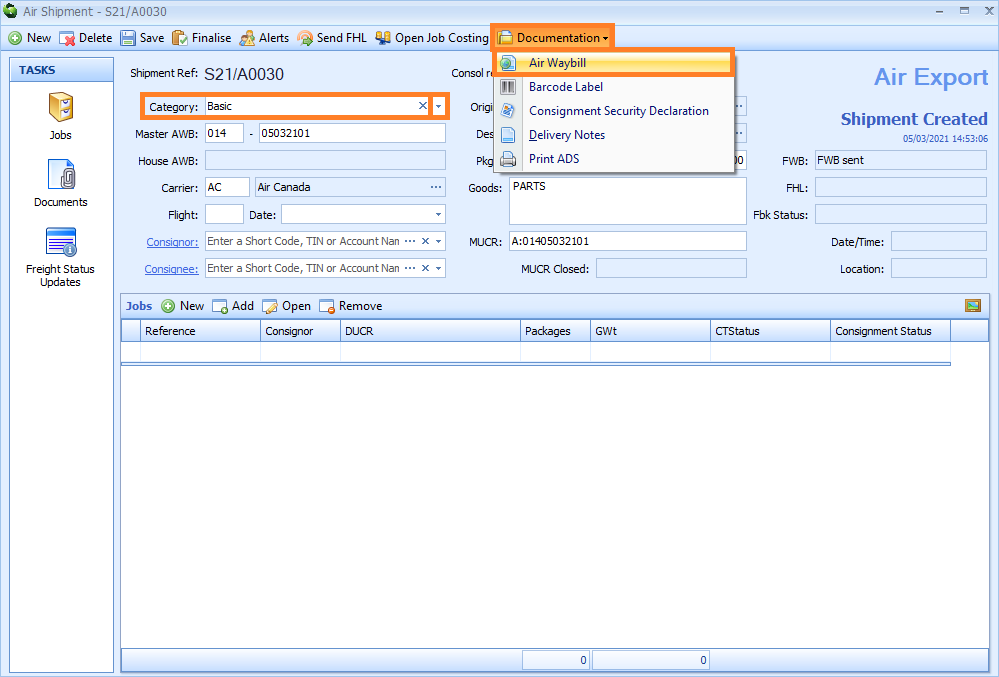
| Category Box | Type of Air Waybill that can be created |
|---|---|
| Basic | Master air waybill |
| House | House air waybill |
| Co-load House | House air waybill |
| Back-to-Back House | Master or House air waybill |
An Air Waybill editor will appear (see Populating an Air Waybill below).
Create an Air Waybill from within a Consolidation Record
Click on the Export module on the bottom left hand side of the screen, then click on the Consolidations folder on top left hand side of the screen. A list of consolidation records will appear. Double click on a consolidation record to open it.
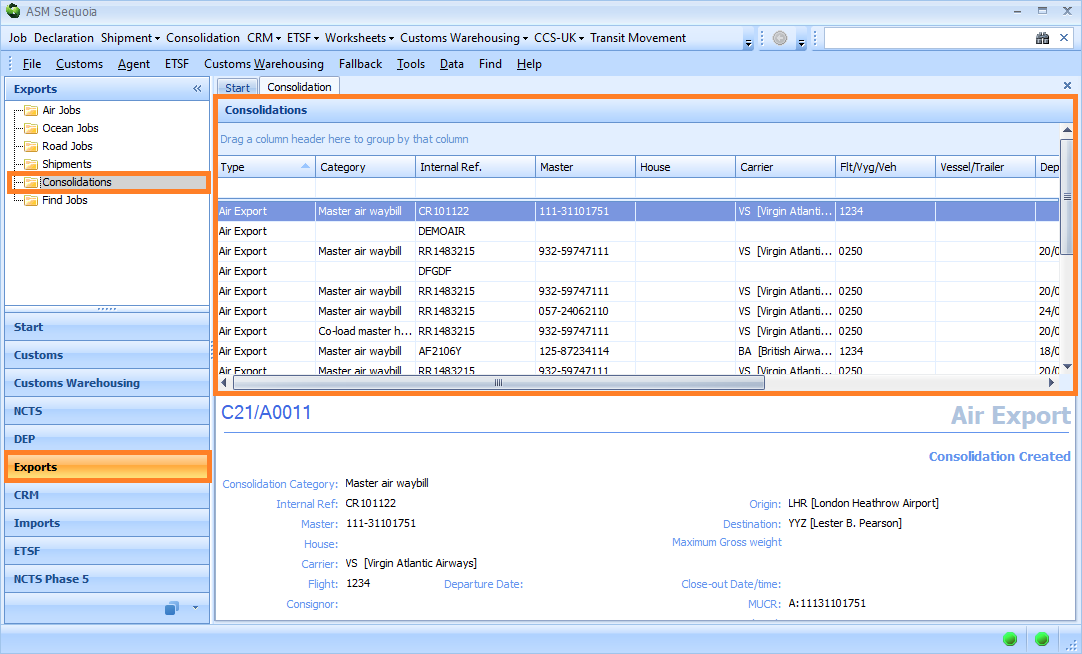
An Air Export Consolidation editor will appear. Click on Documentation on the toolbar at the top of the editor, followed by Air Waybill on the resulting drop down menu.
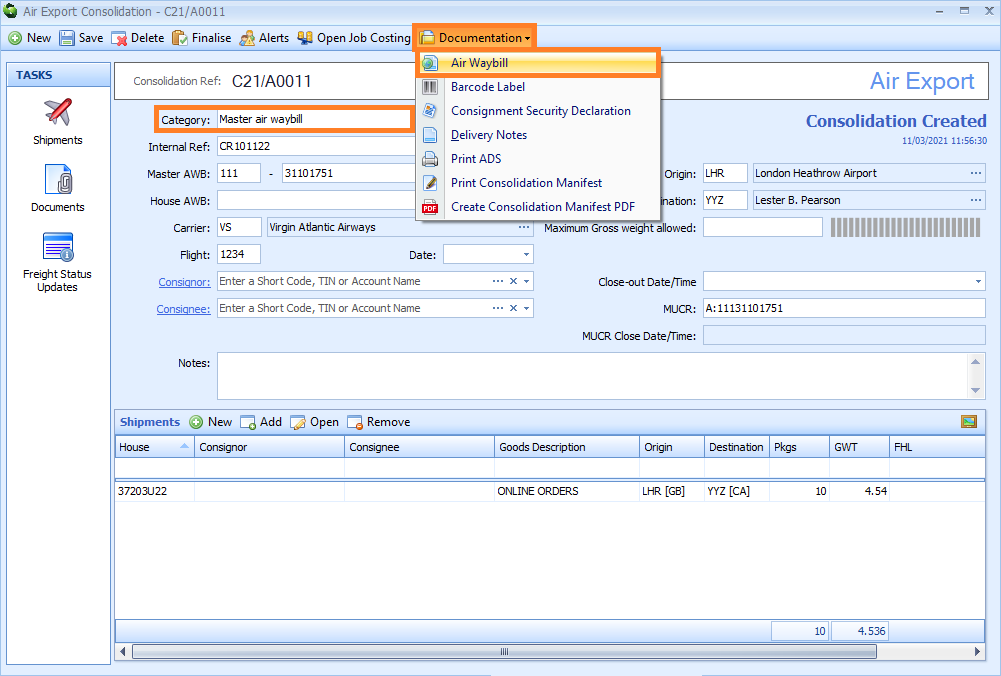
A Master air waybill will be created no matter what is entered into the Category box of the Air Export Consolidation editor.
An Air Waybill editor will appear (see Populating an Air Waybill below).
Populating an Air Waybill
When the Air Waybill editor appears, data will be automatically added from the shipment or consolidation record and from any completed air waybill configurations and standing data (see Air Waybill Configuration and Air Waybill Standing Data). The Air Waybill editor is laid out in a 'what you see is what you get' (WYSIWYG) format, which means that how the data is displayed in the editor is how it will be printed.
Example Master Air Waybill Editor
Below is an example of the layout of the Master Air Waybill editor.
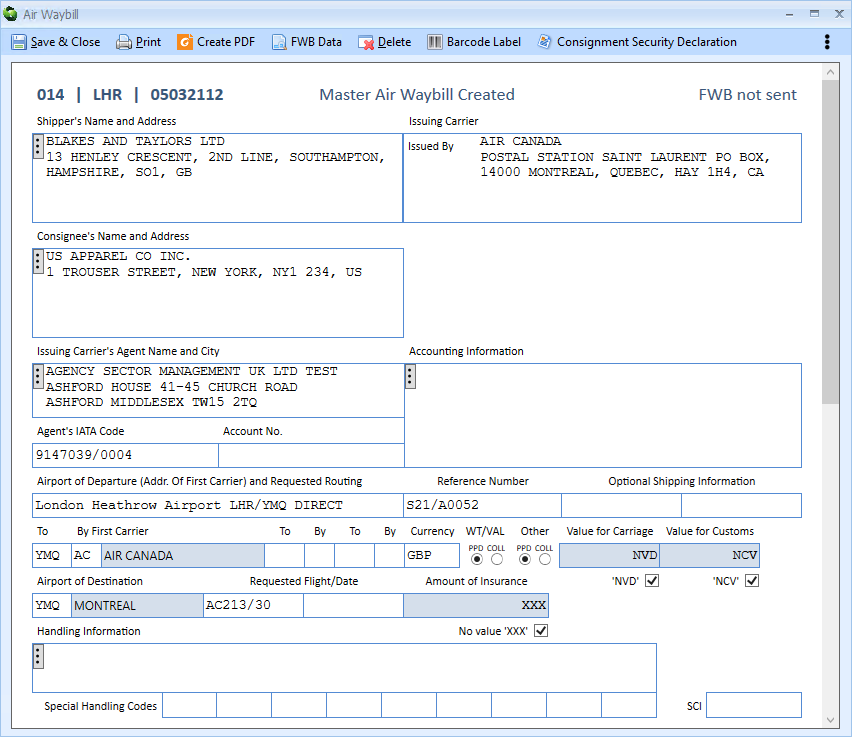
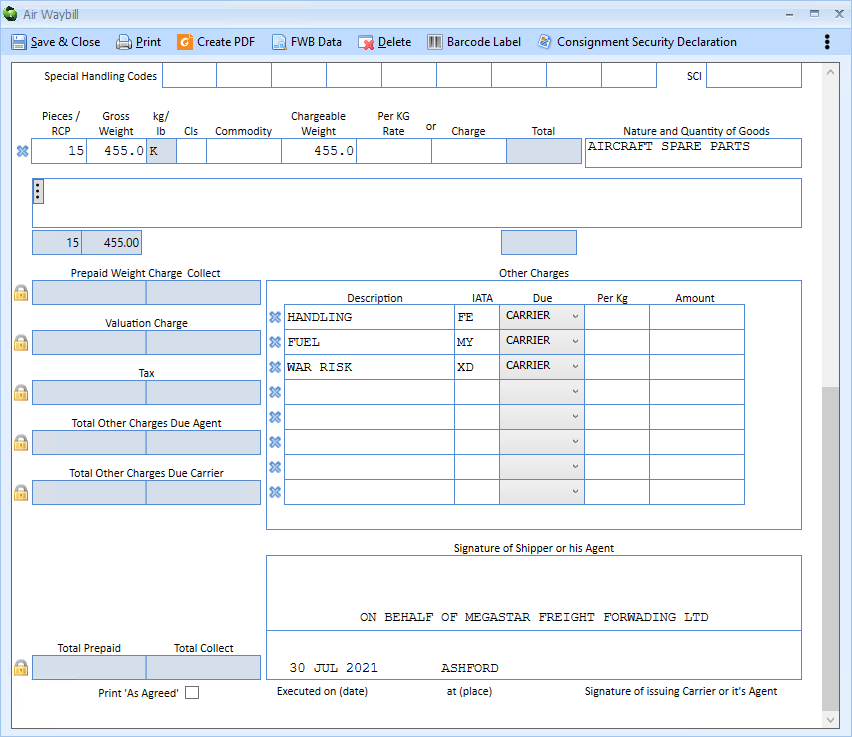
Example House Air Waybill Editor
Below is an example of the layout of the House Air Waybill editor.
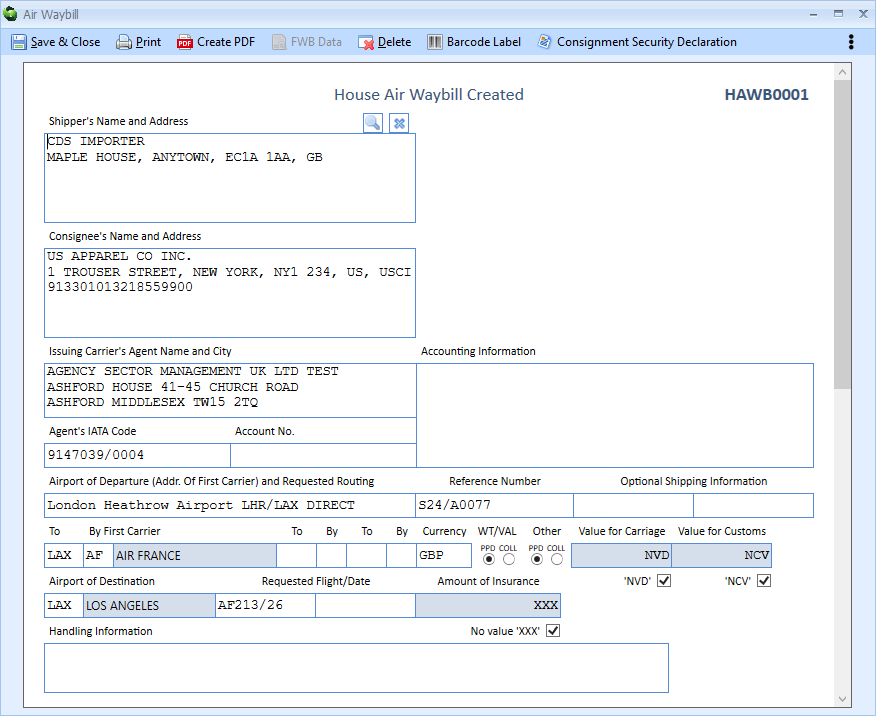
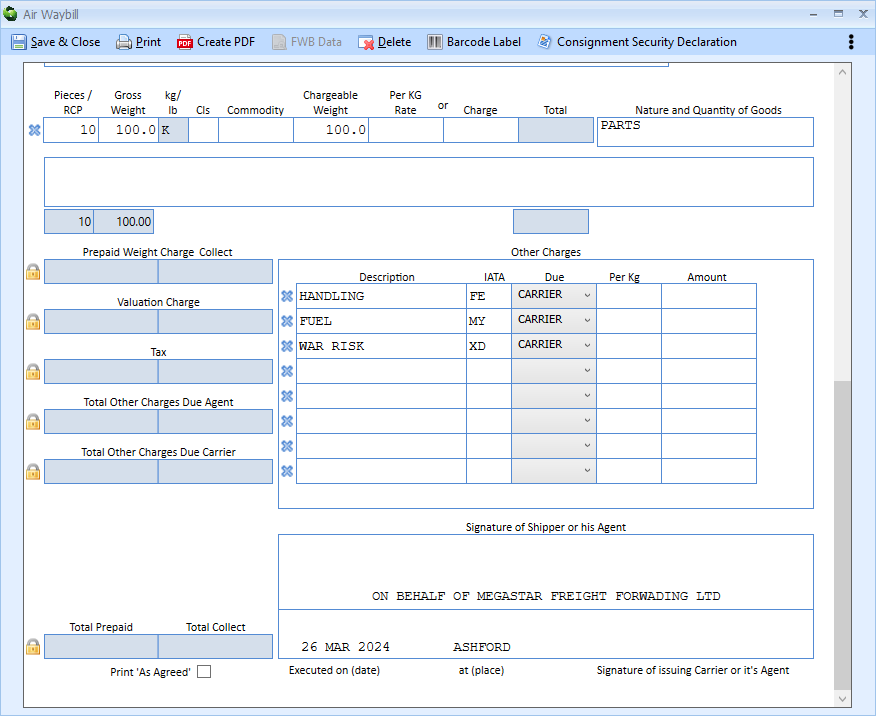
Air Waybill Editor Features
Below is a list of all the Air Waybill editor features and a description of what they do.
Lookups
Lookups allow you to search for information that can be clicked on and added to certain boxes within the Air waybill editor. For example, they can be found in the shipper and consignee boxes, allowing you to search for and add addresses previously entered into your CRM Account. In addition, Lookups are found in the airport code and air carrier boxes when entering any 'onward destination' information.
To use a Lookup, hover over a box with the mouse. A magnifying glass icon will appear  . Click on it and the selectable information will appear. Click on the appropriate information to add it to the box.
. Click on it and the selectable information will appear. Click on the appropriate information to add it to the box.
Clearing Data
If a box on the Air Waybill editor has a cross icon  next to it, you can click on the icon to clear the contents of that box.
next to it, you can click on the icon to clear the contents of that box.
Rating Lines
A rating line is a line on an air waybill where the number of pieces, gross weight and the applicable rate is declared, alongside the total charge for that line. It also includes a description of the goods. In the Air Waybill editor, a rating line contains the boxes Pieces/ RCP, Gross Weight, kg/lb, Cls, Commodity, Chargeable Weight, Per KG Rate or Charge, Total and Nature and Quantity of Goods.
When data is entered into a rating line, Sequoia will automatically add an additional blank rating line below it. In the example shown above, a second, blank, rating line will be added as soon as data is entered into the Cls box. When text is to be printed across the entire rating line, it can be entered in the large box immediately below the rating lines on the Air Waybill editor.
Save & Close button
The air waybill can be saved at any point by clicking on the Save & Close button on the top left hand side of the toolbar.
Print and Create PDF buttons
Once the air waybill has been completed, it can be printed by clicking on the Print button on the top left hand side of the toolbar. To create a PDF version of the air waybill, click on the Create PDF button on the top left hand side of the toolbar.
After clicking on Print or Create PDF, a copy of the air waybill will be added to the Air Shipment or Air Export Consolidation editor and can be found by clicking on the Documents Tasks button in those editors.
Please note that if the air carrier is configured for FWB messaging (see FWB Message Data below), then the FWB message (or FHL in the case of House air waybills) will be sent electronically to the air carrier at the point that the Print or Create PDF buttons are clicked on.
Delete button
Click on the Delete button to delete the air waybill.
Barcode Label button
You will need to complete and save the air waybill in order to access the Barcode Label Button. A Barcode Label is attached to each package that is to be shipped. The barcode identifies the Air Waybill that is related to the package. The "Barcode Label" button allows a user to print x number of copies of the label to affix to their packages.
Consignment Security Declaration button
You will need to complete and save the air waybill in order to access the Consignment Security Declaration button. Clicking on this button will display an editor where the user can complete the details necessary for a Consignment Security Declaration (CSD). When the air waybill data is transmitted to the carrier, the CSD information will be included in the FWB message.
FWB Data button
This button will only be accessible if the air waybill is a Master air waybill. If you are completing a House air waybill, you will not need to enter any FWB data.
Electronic air waybill data, otherwise known as a FWB message, can be sent to an air carrier through Sequoia. Not all air carriers use FWB messages, but those that do must be configured in the 'Air Carriers Data' section of Sequoia to be able to receive them (click here to learn how to do this).
The data sent in the FWB message can differ from that printed on the completed air waybill. This is due to character restrictions in certain boxes within the FWB message. To enter this FWB data, click on FWB Data on the toolbar the top of the Air Waybill editor. A drop down menu will appear, and each menu item can be clicked on to access and edit each FWB Message Data section.
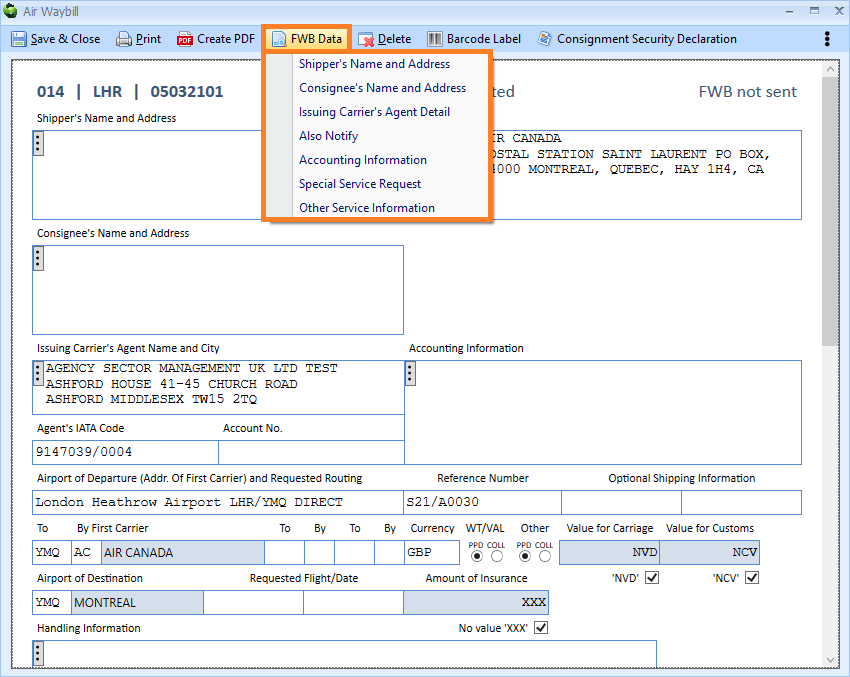
The FWB Message Data editor for each section of the Air Waybill editor can also be accessed by clicking on the  icon in the top left hand corner of some of the boxes.
icon in the top left hand corner of some of the boxes.
In the example below, the Shipper's Name and Address section of the air waybill, and the Shipper's Name and Address section of FWB Message Data is shown. Note the difference between them.
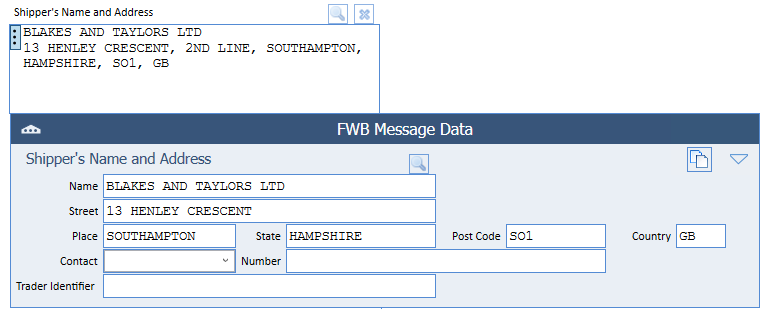
You can also set up which type of FWB data will be shown in which section of the air waybill in the AirWaybill Configuration tab found in the Enterprise Configuration section of the Sequoia Configuration application. Click here for full instructions on how to do this.
In the example below, the Accounting Information Default and Special Service Request Default options have been set up to be displayed in the Accounting section of the Air Waybill editor.

When the FWB Message Data Accounting Information section of the Air Waybill editor is opened, it will now display the FWB Message Data editors for both the Accounting Information and the Special Service Request sections.
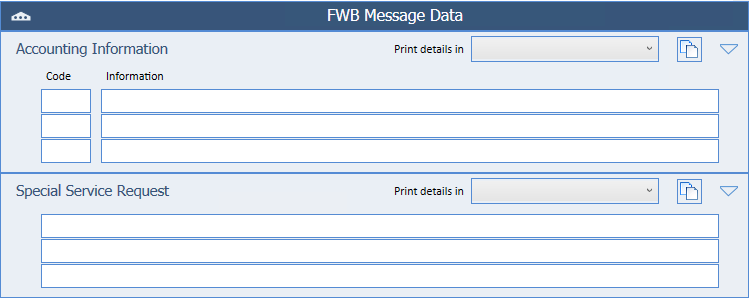
From within the FWB Message Data Accounting Information section, now any text entered can be copied to other sections by selecting the section from the Print details in drop-down list.

In the example below, Handling Information [21] has been selected. Next, click on the Copy Data To Main Editor button, highlighted in orange below.

The text will now appear in the desired section of the air waybill, which, in the example below, is in the Handling Information section.

Once you have finished entering information into each section of the FWB Message Data editor, click on the Close button in the top left hand side, highlighted in orange below.

PLEASE NOTE that once you have completed your air waybill, you MUST click on the Save & Close button on the top left hand side of the toolbar to save it.
